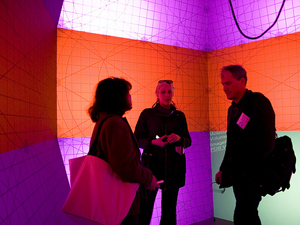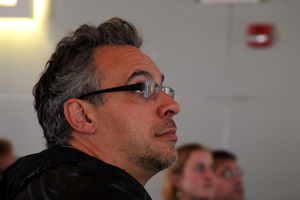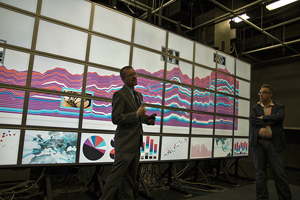UCSD Graduate Students Benefit From Chancellor?s Interdisciplinary Collaboratories Grant to Visualize Cultural Patterns
By Tiffany Fox, (858) 246-0353, tfox@ucsd.edu
San Diego, CA, June 17, 2008 -- Analyzing cultural artifacts such as works of Renaissance literature used to entail a lengthy, musty process of sorting through books and original source documents, one at a time, in the hopes of chancing upon a meaningful pattern. But thanks to an Interdisciplinary Collaboratories grant awarded by UC San Diego Chancellor Marye Anne Fox, graduate researchers at the UCSD division of the California Institute of Telecommunications and Information Technology (Calit2) will soon be able to analyze vast amounts of cultural data using high-tech visualization techniques previously only available to scientists.
|
The grant will provide year-long fellowships of up to $15,000 each to Brynn Evans (Cognitive Science), William Huber (Visual Arts), Ivan Rosero (Communication) and So Yamaoka (Computer Science and Engineering). Funding will be extended for another two years if the team makes satisfactory progress on the proposed project, which is titled “Visualizing Cultural Patterns.”
Leading the research effort will be four UCSD faculty members and affiliates of Calit2: Lev Manovich (Visual Arts), Noah Wardrip-Fruin (Communication), Falko Kuester (Structural Engineering) and Jim Hollan (Cognitive Science).
The project stems from a proposal Manovich wrote shortly after Calit2’s inaugural International Grid (iGrid) 2005 collaborative event, which showcased UCSD’s high-resolution tiled display walls. The latest and highest-resolution such walls include the 286-million-pixel HIPerSpace wall at Calit2 UCSD and the 200-million-pixel HIPerWall at Calit2 on the UC Irvine campus, which are optically networked and can deliver real-time rendered graphics simultaneously across nearly half a billion pixels to audiences in both locations.
“Seeing the amounts of data and the degree of visual detail the HIPerSpace display can support led me to the idea that we can also visualize in detail cultural patterns as opposed to only scientific data,” Manovich said. “For instance, we could track changes in art from the Renaissance to the Baroque period, the common patterns in photographs that people upload to Flickr, and so on.”
Although Manovich never submitted his original proposal for funding, it subsequently served as a launching pad for a challenge issued last year by Calit2 Director Larry Smarr, who asked Manovich and Wardrip-Fruin to create original and visually compelling projects that would make use of the new visual media technologies being developed at Calit2. Those technologies include the 360-degree virtual-reality system known as the STARCave, an innovative Varrier auto-stereo display and the HIPerSpace wall.
The team’s proposal, “Visualizing Cultural Patterns,” aims to develop a new, field-defining methodology for studying cultural data by bringing together experts in the areas of digital media and cultural theory with researchers in computer science and distributed human cognition.
This interdisciplinary collaboration will use Calit2’s innovative technologies to juxtapose visualization techniques normally used in science with those developed for digital design and new media art.
|
“In view of the HIPerSpace wall and the STARCave, Calit2 is perfectly positioned to lead research in the analysis of large visual and media data sets,” Manovich said. “We believe that such visualization environments will be used by a range of people: Social scientists and cultural theorists who professionally study culture, students in art history, media studies, and communication studies classes, museum visitors and cultural creators who want to better understand how their work fits within a larger context.”
Through these new interactive, multi-modal interfaces, the research team hopes to discover previously invisible patterns within the large cultural data sets that are now available, both on the Web (through social networks, blogs, videos and other online content) and through digitization efforts by museums and libraries.
It turns out that the proposal Manovich wrote in 2005 also anticipated a major new research area recently established by the National Endowment for the Humanities (NEH). The Endowment’s “Humanities High-Performance Computing Initiative” is a grant program that encourages humanities scholars to sort through, mine, and better understand and visualize unstructured data such as historical newspapers, books, election data, archaeological fragments, audio or video contents.
“Given that usually funding announcements come first and then researchers respond, this constitutes an unusual sequence of events,” Manovich said, adding that his team will likely seek funding from the NEH initiative, as well as the Mellon Foundation (together with the UCSD Library) and the National Science Foundation Creative IT program.
The “Visualizing Cultural Patterns” project also falls under the rubric of a “Software Studies Initiative” (SSI), which was established last year at Calit2 with funding from the institute itself and the Center for Research in Computing and the Arts (CRCA). According to the SSI Web site, Software Studies “translates into two complementary research paradigms.”
“On the one hand, we want to study software and cyberinfrastructure using approaches from humanities, cultural criticism, and social sciences,” the site says. “On the other hand, we want to bring software-based research methods and cutting-edge cyberinfrastructure tools and resources or the study of the new domain where they have not being applied so far – large sets of cultural data.”
|
Manovich anticipates that the UC Irvine division of Calit2 also will be heavily involved in the “Visualizing Cultural Patterns” project. Members of SSI demonstrated their designs for cultural analytics software at the conference of the Humanities, Arts, Science and Technnology Advanced Collaboratory (HASTAC) at UCI last month, and Manovich and his team have been working with Electrical Engineering and Computer Science Assistant Professor Stephen Jenks (a Calit2-UCI affiliate) to develop an application for the HIPerWall that will allow a presenter to display images and videos across all 50 of the HIPerWall screens and control the way images appear in time and space.
Manovich thinks that while the ability to interactively visualize large sets of cultural data will be useful for researchers who study the past, it is imperative for those who seek to understand contemporary culture.
“Before, cultural theorists and historians could generate theories and histories based on small data sets -- for instance, ‘classical Hollywood cinema’ or ‘Italian Renaissance,’” Manovich said. “But how can we track global digital culture with its billions of cultural objects, and hundreds of millions of contributors?
“Before, you could write about culture by following what was going on in a small number of world capitals and schools. But how can we follow the developments in tens of thousands of cities and educational institutions?
“Impossible as this may sound, this actually can be done.”
Media Contacts
Tiffany Fox, (858) 246-0353, tfox@ucsd.edu
Related Links
Software Studies Initiative




